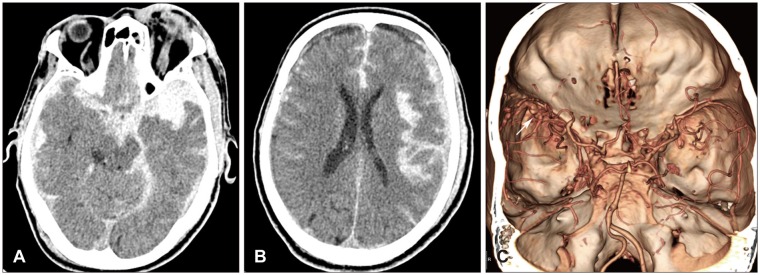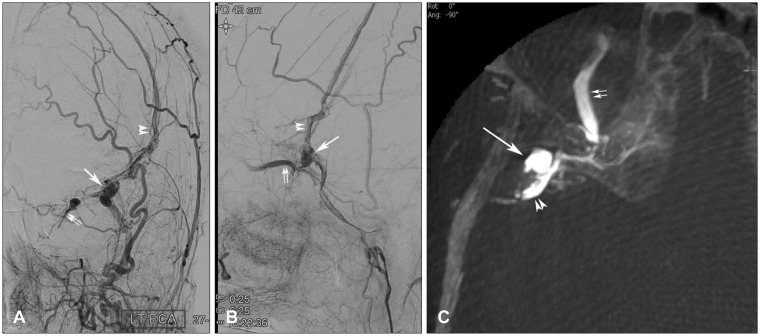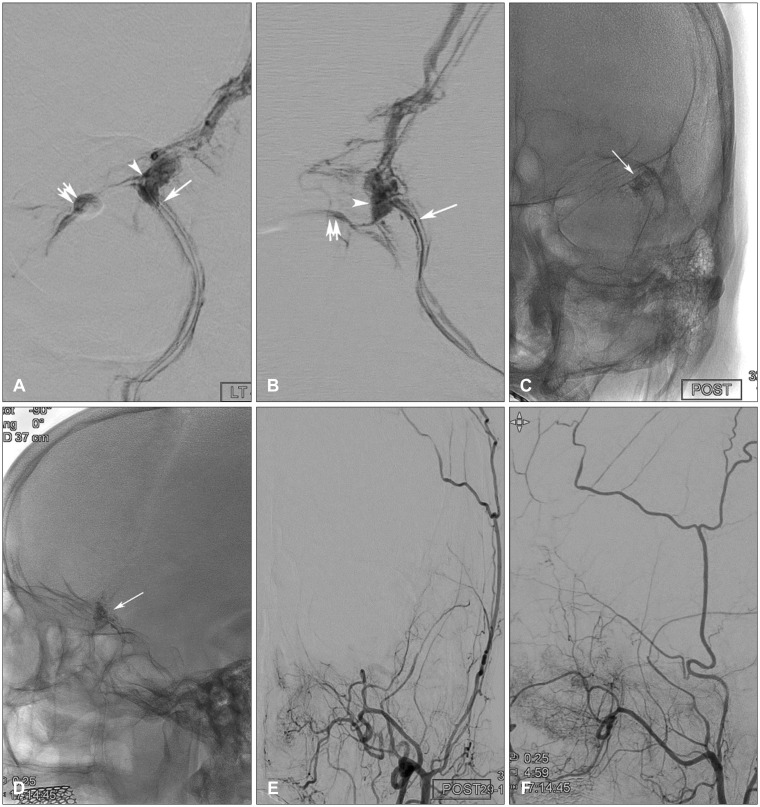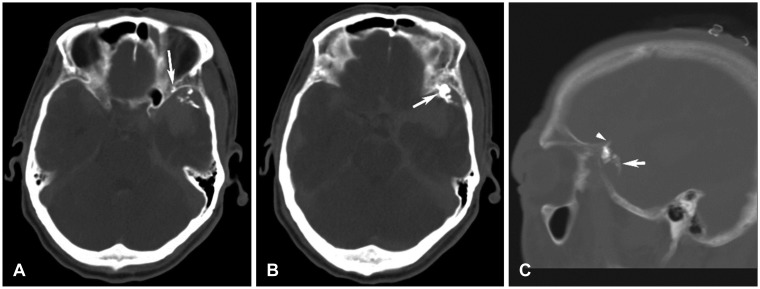Korean J Neurotrauma.
2017 Oct;13(2):162-166. 10.13004/kjnt.2017.13.2.162.
Traumatic Intracerebral and Subarachnoid Hemorrhage Due to a Ruptured Pseudoaneurysm of Middle Meningeal Artery Accompanied by a Medial Sphenoid Wing Dural Arteriovenous Fistula
- Affiliations
-
- 1Department of Neurosurgery, Hallym University Kangdong Sacred Heart Hospital, Hallym University College of Medicine, Seoul, Korea. nsyjlee@gmail.com
- KMID: 2394554
- DOI: http://doi.org/10.13004/kjnt.2017.13.2.162
Abstract
- Traumatic pseudoaneurysms of middle meningeal artery (MMA) and medial sphenoid wing dural arteriovenous fistula (dAVF) are rare. These lesions usually result from traumatic brain injury, and associated with skull fracture. In this paper, the authors report a case of a patient with a ruptured traumatic pseudoaneurysm of MMA and medial sphenoid wing dAVF presented with an intracerebral hemorrhage in the left temporal region and subarachnoid hemorrhage. These lesions were completely obliterated by endovascular treatment, and the patient was recovered without any neurologic deficit. However, 18-day after the procedure, delayed neurologic deficits were developed due to cerebral vasospasm.
MeSH Terms
Figure
Reference
-
1. Bruneau M, Gustin T, Zekhnini K, Gilliard C. Traumatic false aneurysm of the middle meningeal artery causing an intracerebral hemorrhage: case report and literature review. Surg Neurol. 2002; 57:174–178. PMID: 12009543.2. Carney N, Totten AM, O'Reilly C, Ullman JS, Hawryluk GW, Bell MJ, et al. Guidelines for the management of severe traumatic brain injury, fourth edition. Neurosurgery. 2017; 80:6–15. PMID: 27654000.
Article3. Connolly ES Jr, Rabinstein AA, Carhuapoma JR, Derdeyn CP, Dion J, Higashida RT, et al. Guidelines for the management of aneurysmal subarachnoid hemorrhage: a guideline for healthcare professionals from the American Heart Association/american Stroke Association. Stroke. 2012; 43:1711–1737. PMID: 22556195.4. Lim DH, Kim TS, Joo SP, Kim SH. Intracerebral hematoma caused by ruptured traumatic pseudoaneurysm of the middle meningeal artery : a case report. J Korean Neurosurg Soc. 2007; 42:416–418. PMID: 19096582.
Article5. Oertel M, Boscardin WJ, Obrist WD, Glenn TC, McArthur DL, Gravori T, et al. Posttraumatic vasospasm: the epidemiology, severity, and time course of an underestimated phenomenon: a prospective study performed in 299 patients. J Neurosurg. 2005; 103:812–824. PMID: 16304984.
Article6. Paiva WS, de Andrade AF, Amorim RL, Figueiredo EG, Teixeira MJ. Traumatic pseudoaneurysm of the middle meningeal artery causing an intracerebral hemorrhage. Case Rep Med. 2010; 2010:219572. PMID: 20589087.
Article7. Salazar Flores J, Vaquero J, Garcia Sola R, Rossi E, Martinez R, Martinez P, et al. Traumatic false aneurysms of the middle meningeal artery. Neurosurgery. 1986; 18:200–203. PMID: 3960300.
Article8. San Millán Ruíz D, Fasel JH, Rüfenacht DA, Gailloud P. The sphenoparietal sinus of breschet: does it exist? An anatomic study. AJNR Am J Neuroradiol. 2004; 25:112–120. PMID: 14729539.9. Sandin JA 3rd, Salamat MS, Baskaya M, Dempsey RJ. Intracerebral hemorrhage caused by the rupture of a nontraumatic middle meningeal artery aneurysm. Case report and review of the literature. J Neurosurg. 1999; 90:951–954. PMID: 10223464.10. Shi ZS, Ziegler J, Feng L, Gonzalez NR, Tateshima S, Jahan R, et al. anatomic and treatment considerations. AJNR Am J Neuroradiol. 2013; 34:373–380. PMID: 22790245.
- Full Text Links
- Actions
-
Cited
- CITED
-
- Close
- Share
- Similar articles
-
- Intracerebral Hematoma Caused by Ruptured Traumatic Pseudoaneurysm of the Middle Meningeal Artery: A Case Report
- Angiographically Progressive Change of Traumatic Pseudoaneurysm Arising from the Middle Meningeal Artery
- Rupture of a Middle Meningeal Artery Pseudoaneurysm in Moyamoya Syndrome Related with Tuberculous Meningitis
- Subarachnoid Hemorrhage Due to a Ruptured Middle Cerebral Artery Bifurcation Aneurysm Superimposed by an Idiopathic Intracerebral Hematoma
- Borden Type I Sigmoid Sinus Dural Arteriovenous Fistula Presenting as Subarachnoid Hemorrhage from a Feeding Artery Aneurysm of the Anterior Inferior Cerebellar Artery: A Case Report






